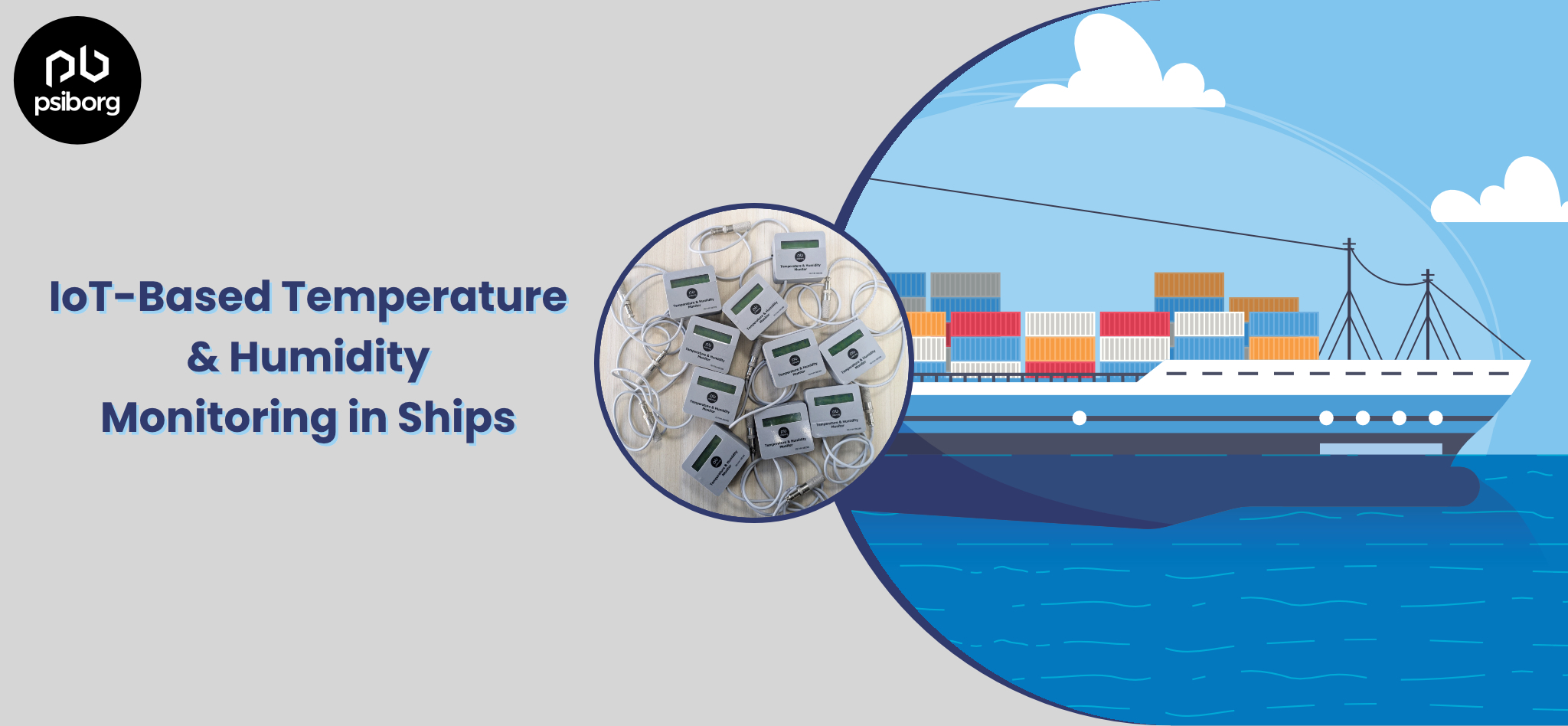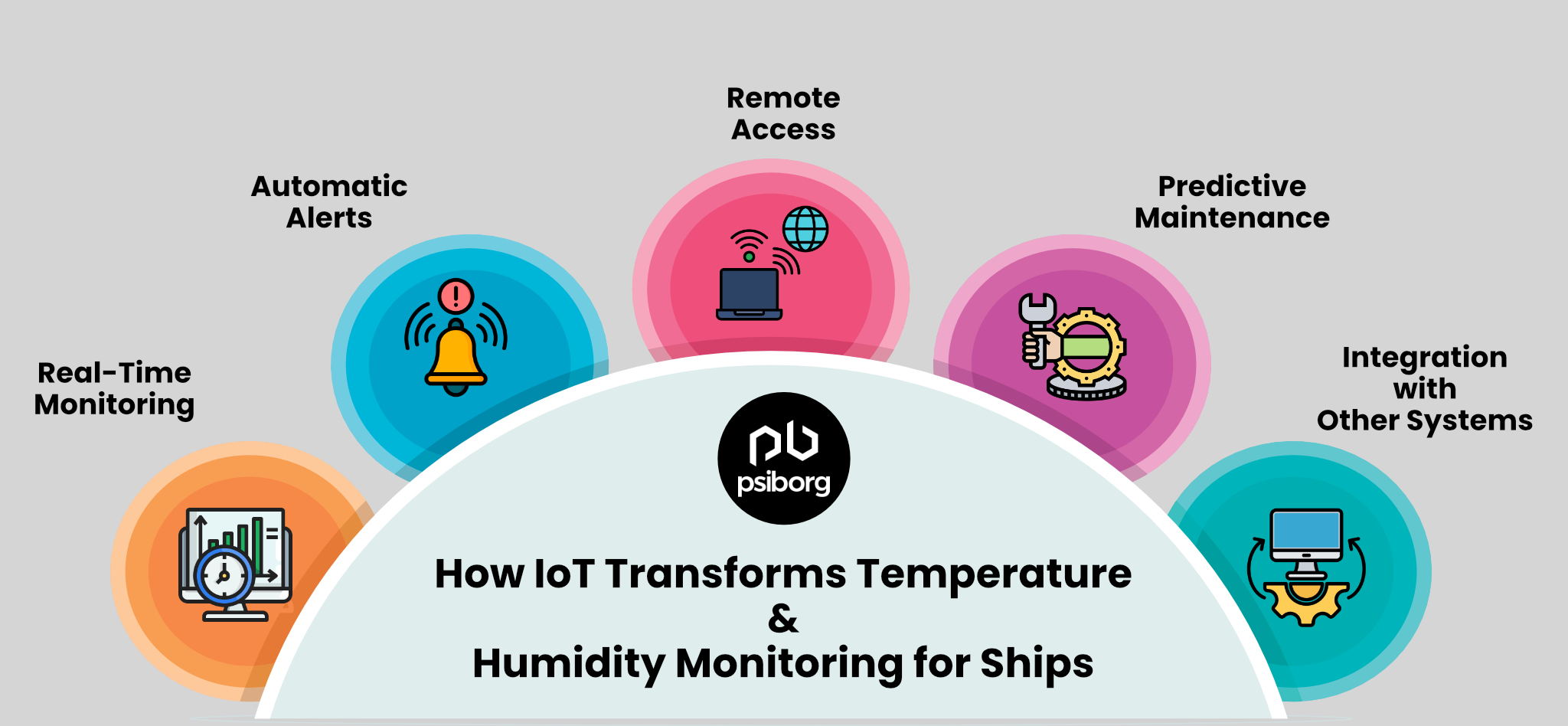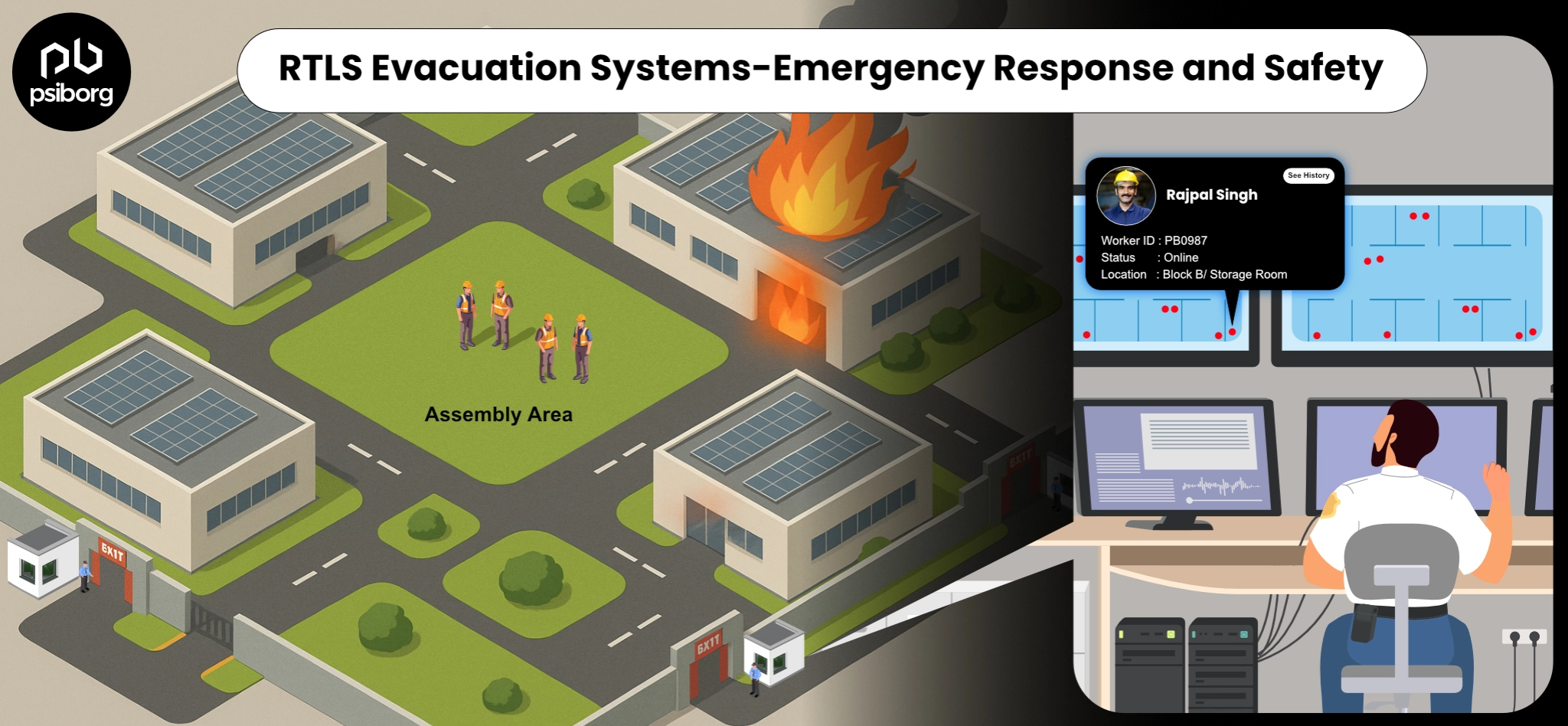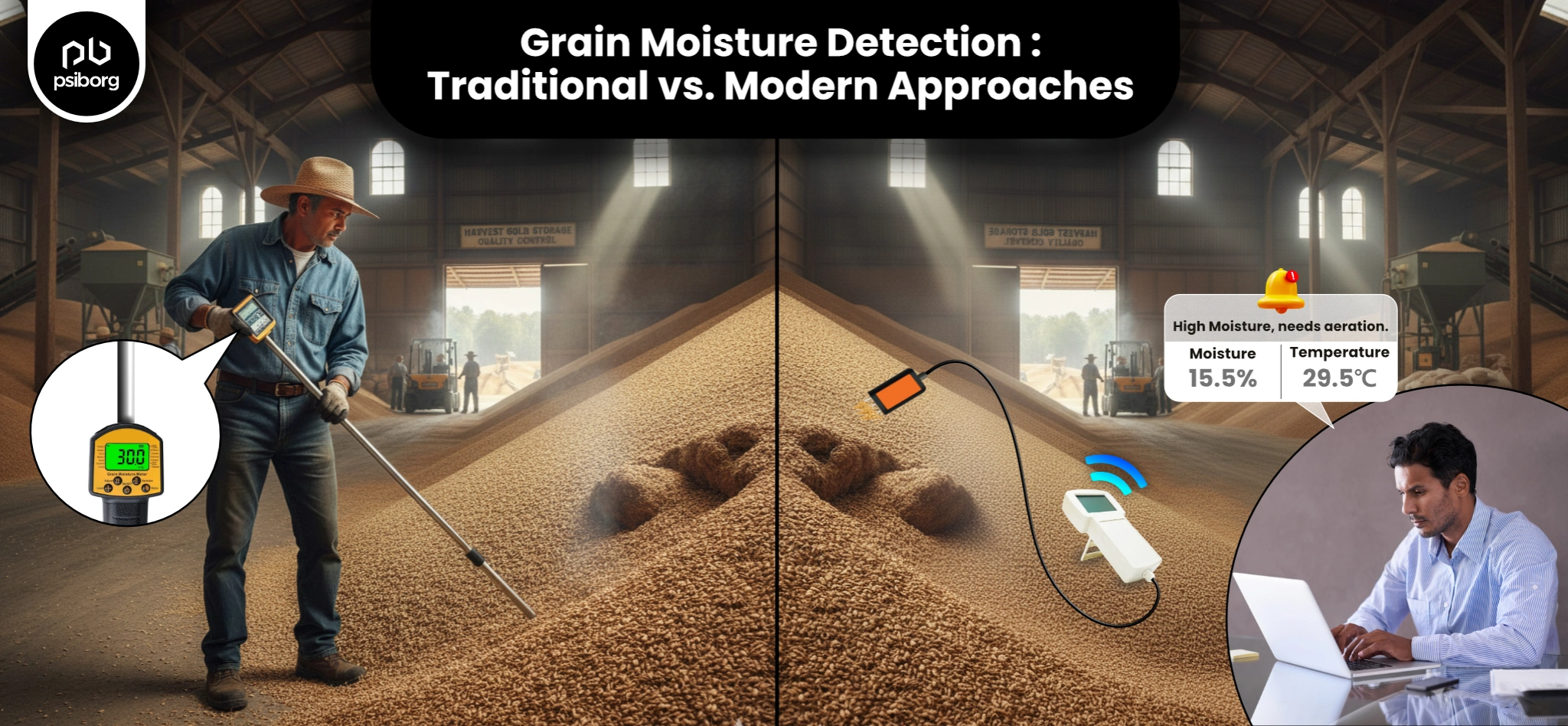Cargo ships are often carrying tons of perishable goods across oceans. Such items are temperature-sensitive. If there’s a sudden temperature spike or excessive humidity, it could lead to massive losses. Without a reliable system in place, one can’t efficiently monitor environmental factors manually. There are always chances of errors, and so we need a reliable system to count on. IoT-based temperature and humidity monitoring systems are just what these ships need. They provide real-time data, send automated alerts and provide ship operators with the required tools to make sure everything and everyone is safe.
Safety on the ships isn’t just limited to goods but also to the crew. A vessel navigates through diverse climatic conditions. Fluctuations in temperature can also affect health of the workers onboard, hinder operational efficiency and cause structural damage. IoT-based temperature and humidity monitoring systems ensure a stable onboard environment.
Understanding the Importance of Temperature and Humidity Monitoring in Ships

From freezing waters to hot tropical regions, ships travel across different climatic zones. The variation in these environments causes huge fluctuations in temperature and humidity because there’s no stability in the climate. Without proper monitoring, these temperature changes can have certain negative effects:
Cargo Damage
Certain items like food, medicines and chemicals always need controlled storage conditions to not spoil. Excess humidity can be damaging and extreme temperatures can reduce product quality and effectiveness.
Electronic and Mechanical Issues
For proper navigation and communication, ships heavily rely on advanced electronic systems. It must be noted that excess humidity can cause condensation which in turn, leads to short circuits and corrosion.
Crew Health and Comfort
It’s not just the goods being carried but also the people on board that must be given attention. An optimal environment inside the ship is extremely important to keep them mentally and physically well because temperature issues and severe humidity can cause dehydration, fatigue, and even breathing problems.
Structural Integrity
Since the vessels are sailing and always in contact with the water, their metal components can get rusted and corroded. With temperature and humidity monitoring systems in ships it’s possible to detect such risks in time and take maintenance action.
How IoT Transforms Temperature and Humidity Monitoring for Ships
While manual readings and mechanical devices are traditionally used to monitor environmental conditions on ships, they have their own limitations. You can always expect some delays in detection and human errors and they can’t be taken lightly. The temperature and humidity monitoring for ships using IoT can help a lot by offering a bunch of amazing advantages:

Real-Time Monitoring
There’s constant data collection by the sensors that are placed throughout the ship. The collected data is then sent to a central system.
Automatic Alerts
If there’s much change in the temperature or humidity levels exceed set limits, the system sends instant alerts to the person in charge.
Remote Access
Crew members and operators can easily monitor temperature conditions from anywhere with the help of smartphones, tablets or computer dashboards.
Data Analytics and Predictive Maintenance
IoT systems in place can properly analyze past data to predict if there can be any potential failures and recommend taking proactive actions.
Integration with Other Systems
Automatic environmental adjustments are possible by integrating IoT solutions with HVAC (Heating, Ventilation, and Air conditioning) and refrigeration units.
Components of an IoT-Based Temperature and Humidity Monitoring System in Ships
A well-efficient temperature and humidity monitoring system in ships includes several important components:
IoT Sensors
These sensors are smartly placed at different locations so that temperature and humidity levels can be measured accurately. There are temperature sensors, humidity sensors and environmental monitoring units to keep recording data for use.
Gateway Devices
Once these devices collect sensor data, they send it to cloud-based systems through wireless communication like Wi-Fi, Bluetooth or LoRaWAN.
Cloud Storage & Processing
The received data is safely stored in the cloud. AI-driven analytics access and process it to determine if there’s a pattern, detect anomalies and identify potential risks.
User Interface
It’s basically a dashboard that offers live visualization of data and generates automated reports. It also allows for remote access to data access to monitor and adjust it.
Alert Mechanism
If conditions start getting out of control or extend a desired acceptance level, the system sends notifications via SMS, email, or alarms so the staff can take timely action.
Control Systems
Automated systems that work along the HVAC and refrigeration units offer necessary data based on which real-time adjustments can be made.
Benefits of Using IoT for Temperature and Humidity Monitoring in Ships
1. Safety and Compliance:
By maintaining optimum conditions, IoT helps ships maintain temperature and control humidity levels. This is how cargo companies can prevent penalties, product recalls, and unnecessary losses.
2. Cost Savings:
By early detection and intervention, the system prevents damage to cargo, electronic items and even ship infrastructure. This helps reduce a lot of repair and replacement costs. Plus, with fewer manual checks, there is labor expense and improved operational efficiency.
3. Energy Efficiency:
By combining IoT sensors with HVAC and refrigeration systems, ships can put energy to the best use. Unnecessary power consumption is minimized and fuel costs are cut down.
4. Extended Life of Equipment:
Constant fluctuations in temperature and humidity can ruin the ship components, especially electrical and mechanical. IoT offers predictive maintenance that detects potential failures. The timely repairs can thus prolong the lifespan of critical equipment.
5. Well-being of the Crew
The staff needs a stable environment onboard for their physical and mental health. IoT makes it easier to create comfortable conditions for living and working. This reduces temperature-associated issues like heat strokes, dehydration and respiratory concerns.
6. Better Decision-Making
Ship operators get valuable insights based on past and present data. This information helps in making correct decisions regarding maintenance, route planning, and optimization of the system.
7. Remote Monitoring and Control
IoT-enabled dashboards help ship operators and control teams monitor environmental conditions in real time from anywhere. This enables them to manage and take swift action in cases where required.
Effect of Prolonged High Humidity on the Human Body
Now that we have learned about the technical aspects of temperature and humidity monitoring in ships, it’s time to understand the effects of high humidity on the human body. Since the crew members work in confined environments for a very long time, here’s what they can face:
Heat-related issues and Dehydration
High humidity doesn’t let the sweat evaporate and so the body is unable to cool itself. This is why people face heat strokes, dehydration and exhaustion in hot climate.
Respiratory Issues
A lot of moisture in the air attracts the formation of mold and encourage bacteria growth. This formation of the surfaces around can cause breathing difficulties and dangerous allergies.
Skin Problems
The more humidity, the more sweating. Now this excess sweat causes rashes, fungal infections and other skin concerns.
Mental Fog
Beyond skin issues, high humidity also causes a lot of discomfort and fatigue. Hot weather doesn’t let workers focus nor do they react properly to situations. This also causes delays in ship operations.
Existing Conditions Worsen
Humidity makes it even more difficult for individuals already suffering from problems like asthma, arthritis, or heart conditions.
Conclusion
With everything going digital, temperature and humidity monitoring for ships using IoT must also be considered for streamlined overall ship management. This smart system can help ships stay safer, more efficient and cost-efficient. The crew members are safe & healthy and the cargo stays as good. Do also read our case study on the temperature and humidity monitoring system.
The evolution of the shipping industry calls for investing in advanced temperature and humidity monitoring system in ships. Besides providing operational efficiency, it will also ensure sustainable maritime transport. IoT is certainly a promising smarter and safer future at sea.
FAQs
Only by maintaining proper temperature and humidity levels, perishable goods can be prevented from getting spoiled. High humidity cause rusting in different parts of the ship which leads to costly repairs and even safety risks. Moreover, extreme conditions are not good for the health of crew members. By maintaining temperature, ships also comply with maritime regulations.
Besides temperature and humidity, IoT-based systems can efficiently maintain safety by tracking air pressure, CO2 levels and water quality. It monitors engine performance, fuel consumption and vibration levels as well to detect inefficiencies, prevent mechanical failures and minimize risks.
Yes, IoT systems securely store all previous data in cloud platforms. Ship operators can easily access it to analyze patterns and make data-driven decisions. It makes it easier to detect repeat issues and predict the need for maintenance needs. Accessing past records is the best to optimize future voyages.





